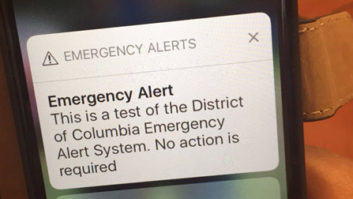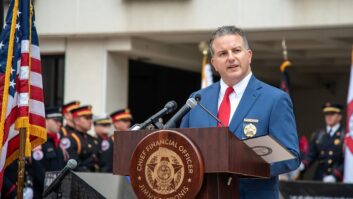WASHINGTON The Federal Communications Commission and public warning advocates are looking for ways to alert hurricane-prone coastal regions about threats more quickly.
The FCC and the Federal Emergency Management Agency plan to make more use of a system that measures broadcast transmissions before and after a hurricane.
To that end, representatives from the FCC’s Public Safety and Homeland Security Bureau say that a renewed spirit of cooperation between the commission and FEMA, to make sure their efforts complement each other, will result in improved public warnings and quicker restoration of broadcast services after a disaster.

Field agents Paul Coburn, left, and Loyd Perry use a spectrum analyzer in Louisiana as part of the FCC’s Project Roll Call system, which measures broadcast activity within a 30-mile radius before and after a hurricane. After the commission reviewed 2008 hurricane data, Derek Poarch, chief of the bureau, said, “We have learned much that will allow us to take steps and use those lessons learned to prepare for the next disaster.”
He spoke at a hurricane “summit” in December that focused on communications and coordination among state, local and federal governments.
This year, the FCC expects to emphasize the Project Roll Call system, a joint program with FEMA that uses data collected by commission field engineers equipped with spectrum analyzers to measure disaster broadcast activity within a 30 mile radius before a threatening event, and again afterwards.
Project Roll Call establishes a baseline of station activity prior to the event to give emergency managers an immediate idea of who is on the air broadcasting critical information to the public, said Shawn Lapinski, associate chief of the bureau.
“FCC field engineers collect the data with a spectrum analyzer prior to a forecasted disaster and then go back in after the disaster to determine (if any stations) may need some help,” Lapinski said.
Project Roll Call was implemented three times in 2008; the commission will use it more often in the coming year, Lapinski said. The system also can measure public safety, wireless phone and other critical infrastructure communication systems, such as two-way communications.
FEMA and the FCC acknowledge that Project Roll Call is only beneficial when officials can see a threat coming and field engineers have time to get to the geographic area that could be affected. It is not intended for use after unforeseen emergencies.
Representatives of the broadcast industry at the summit spoke of issues facing broadcasters in the hours after a hurricane.
Ann Arnold, president of the Texas Broadcasters Association, said broadcasters along the Texas Gulf Coast region had trouble accessing transmitter sites in the aftermath of Ike last year.
“Credentialing remains a major issue and how to get through the multitude of roadblocks by local police and the National Guard. Moving in and out the affected areas to repair damage is very troublesome for broadcasters,” she said.

In his December presentation, Joe Casey, associate bureau chief of the FCC’s Public Safety and Homeland Safety Bureau, discussed the Project Roll Call equipment which includes a Rohde & Schwarz FSL3 spectrum analyzer (top shelf); an ICOM PCR2500 receiver (middle, left), a Uniden 996 scanner (middle, right) and a computer (bottom). The gear is mounted in a shock-protected box. Arnold said the number of area radio stations knocked off the air by Ike went up the after the storm as generator fuel ran out.
Pat Roberts, president of the Florida Association of Broadcasters, said there are ways broadcasters can improve the preparation and restoration processes.
“Pre-positioning of assets is crucial for the commercial sector. Having fuel and water reserves in place is important. Pre-arranged contracts with fuel providers is also crucial,” Roberts said. “Florida broadcasters are doing a better job of doing all of those things.”
It appears broadcasters in other states are, too, industry observers said. At least some broadcast groups, such as Clear Channel and Cumulus, have implemented specific hurricane readiness plans along states on the Gulf Coast.
Arnold and Roberts feel FEMA has been mostly unsympathetic to the infrastructure needs of broadcasters after catastrophic disasters. Others say the issue isn’t that simple.
“Broadcast is very important. We understand that,” said Dr. Gordon Fullerton, director of systems engineering and technology development for FEMA. “However, by legal statute, (FEMA) is strictly prohibited from assisting for-profit organizations. FEMA cannot give a generator to a radio station.
“However, there is a caveat. When it comes down to being a public safety hazard, we try to get around the legal obstacles when we can. We are not going to let people die when it comes to getting out public safety information.”
Arnold was complimentary of actions taken by the FCC. “We are appreciative of the FCC being proactive and impressed by their efforts and expertise” during and after last year’s storms.
Hurricanes Fay, Gustov and Ike were the most dangerous and damaging storms of 2008, contributing to more than 100 deaths in the United States.
Colorado State University forecasters predict the 2009 hurricane season to be “above average,” with 14 named storms in the Atlantic Ocean, and seven of those becoming hurricanes.












